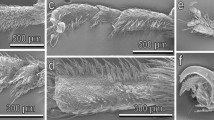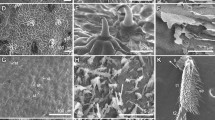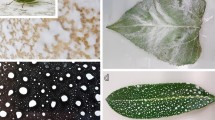Abstract
The present paper characterizes the attachment ability of males and females of Nezara viridula (Heteroptera: Pentatomidae) on artificial surfaces (smooth hydrophilic, smooth hydrophobic, different surface roughness) and on both leaf surfaces of the typical host plant species Vicia faba, using a centrifugal force tester and a traction force experiments set up. N. viridula is a serious crop pest in the world and shows attachment devices different from the so far investigated Heteroptera, with a tarsus characterized by distal smooth flexible pulvilli combined with claws and proximal ventral hairy pad. Notwithstanding the different body mass between the sexes, no difference was found between friction forces generated by females and males. Friction force was higher on hydrophilic surfaces than on hydrophobic ones and was lower on both sides of V. faba leaf compared with both hydrophilic and hydrophobic artificial smooth surfaces. On the surfaces with different roughness, the friction force values varied significantly, with the higher attachment ability on the surface with very high asperity size followed by the smooth surface. The lowest attachment was on the surfaces with intermediate asperity sizes. These results could be related to the specific combination of attachment devices of N. viridula.







Similar content being viewed by others
References
Al Bitar L, Voigt D, Zebitz CPW, Gorb SN (2009) Tarsal morphology and attachment ability of the codling moth Cydia pomonella L. (Lepidoptera, Tortricidae) to smooth surfaces. J Insect Physiol 55:1029–1038
Arnold JW (1974) Adaptive features on the tarsi of cockroaches (Insecta: Dictyoptera). Int J Insect Morphol Embryol 3:317–334
Betz O (2002) Performance and adaptive value of tarsal morphology in rove beetles of the genus Stenus (Coleoptera, Staphylinidae). J Exp Biol 205:1097–1113
Beutel R, Gorb SN (2001) Ultrastructure of attachment specializations of hexapods (Arthropoda): evolutionary patterns inferred from a revised ordinal phylogeny. J Zool Syst Evol Res 39:177–207
Beutel RG, Gorb SN (2006) A revised interpretation of the evolution of attachment structures in Hexapoda with special emphasis on Mantophasmatodea. Arthropod Syst Phylo 64:3–25
Beutel RG, Gorb SN (2008) Evolutionary scenarios for unusual attachment devices of Phasmatodea and Mantophasmatodea (Insecta). Syst Entomol 33:501–510
Brainerd EL (1994) Adhesion force of ants on smooth surfaces. Am Zool 34:128
Bullock JMR, Federle W (2009) Division of labour and sex differences between fibrillar, tarsal adhesive pads in beetles: effective elastic modulus and attachment performance. J Exp Biol 212:1876–1888
Clemente CJ, Federle W (2008) Pushing versus pulling: division of labour between tarsal attachment pads in cockroaches. Proc R Soc B 275:1329–1336
Colazza S, Bin F (1995) Efficiency of Trissolcus basalis (Hymenoptera: Scelionidae) as an egg parasitoid of Nezara viridula (Heteroptera: Pentatomidae) in Central Italy. Environ Entomol 24:1703–1707
Dai Z, Gorb SN, Schwarz U (2002) Roughness-dependent friction force of the tarsal claw system in the beetle Pachnoda marginata (Coleoptera, Scarabaeidae). J Exp Biol 205:2479–2488
Dirks J-H, Federle W (2011) Fluid-based adhesion in insects—principles and challenges. Soft Matter 7:11047
Dixon AFG, Croghan PC, Gowing RP (1990) The mechanism by which aphids adhere to smooth surfaces. J Exp Biol 152:243–253
Endlein T, Federle W (2008) Walking on smooth or rough ground: passive control of pretarsal attachment in ants. J Comp Physiol A 194:49–60
Endlein T, Federle W (2015) On heels and toes: How ants climb with adhesive pads and tarsal friction hair arrays. PLoS One 10:1–16. doi:10.1371/journal.pone.0141269
Federle W, Endlein T (2004) Locomotion and adhesion: dynamic control of adhesive surface contact in ants. Arthropod Struct Dev 33:67–75
Federle W, Rohrseitz K, Hölldobler B (2000) Attachment forces of ants measured with a centrifuge: better ‘wax-runners’ have a poorer attachment to a smooth surface. J Exp Biol 203:505–512
Federle W, Brainerd EL, McMahon TA, Hölldobler B (2001) Biomechanics of the movable pretarsal adhesive organ in ants and bees. Proc Natl Acad Sci USA 98:6215–6220
Federle W, Riehle M, Curtis ASG, Full RJ (2002) An integrative study of insect adhesion mechanics and wet adhesion of pretarsal pads in ants. Integr Comp Biol 42:1100–1106
Frantsevich L, Gorb SN (2002) Arcus as a tensegrity structure in the arolium of wasps (Hymenoptera: Vespidae). Zoology 105:225–237
Frantsevich L, Gorb S (2004) Structure and mechanics of the tarsal chain in the hornet, Vespa crabro (Hymenoptera: Vespidae): implications on the attachment mechanism. Arthropod Struct Dev 33:77–89
Frantsevich L, Ji A, Dai Z, Wang J, Frantsevich LA, Gorb SN (2008) Adhesive properties of the arolium of a lantern-fly, Lycorma delicatula (Auchenorrhyncha, Fulgoridae). J Insect Physiol 54:818–827
Ghazi-Bayat A, Hasenfuss I (1980) Zur Herkunft der Adhäsionsflüssigkeit der tarsalen Haftlappen bei den Pentatomidae (Heteroptera). Zool Anz 204:13–18
Gladun D, Gorb SN, Frantsevich LI (2009) Alternative tasks of the insect arolium with special reference to Hymenoptera. In: Gorb SN (ed) Functional surfaces in biology—adhesion related phenomena, vol 2. Springer, Heidelberg, pp 67–103
Gorb SN (2001) Attachment devices of insect cuticle. Kluwer Academic, Dordrecht
Gorb S (2005) Uncovering insect stickiness: structure and properties of hairy attachment devices. Am Entomol 51:31–35
Gorb SN (2007) Visualisation of native surfaces by two-step molding. Microsc Today 15:44–46
Gorb EV, Gorb SN (2002) Attachment ability of the beetle Chrysolina fastuosa on various plant surfaces. Entomol Exp Appl 105:13–28
Gorb SN, Gorb EV (2004) Ontogenesis of the attachment ability in the bug Coreus marginatus (Heteroptera, Insecta). J Exp Biol 207:2917–2924
Gorb E, Gorb S (2009) Functional surfaces in the pitcher of the carnivorous plant Nepenthes alata: a cryo-SEM approach. In: Gorb SN (ed) Functional surfaces in biology—adhesion related phenomena, vol 2. Springer, Heidelberg, pp 205–238
Gorb SN, Scherge M (2000) Biological microtribology: anisotropy in frictional forces of orthopteran attachment pads reflects the ultrastructure of a highly deformable material. Proc R Soc Lond B 267:1239–1244
Gorb SN, Jiao Y, Scherge M (2000) Ultrastructural, architectural and mechanical properties of attachment pads in Tettigonia viridissima (Orthoptera, Tettigoniidae). J Comp Physiol A 186:821–831
Gorb SN, Gorb EV, Kastner V (2001) Scale effects on the attachment pads and friction forces in syrphid flies (Diptera, Syrphidae). J Exp Biol 204:1421–1431
Gorb SN, Beutel RG, Gorb EV, Jiao Y, Kastner V, Niederegger S, Popov VL, Scherge M, Schwarz U, Vötsch W (2002) Structural design and biome- chanics of friction-based releasable attachment devices in insects. Integr Comp Biol 42:1127–1139
Gorb E, Kastner V, Peressadko A, Arzt E, Gaume L, Rowe N, Gorb S (2004) Structure and properties of the glandular surface in the digestive zone of the pitcher in the carnivorous plant Nepenthes ventrata and its role in insect trapping and retention. J Exp Biol 207:2947–2963
Gorb EV, Hosoda N, Miksch C, Gorb SN (2010) Slippery pores: anti-adhesive effect of nanoporous substrates on the beetle attachment system. J R Soc Interface 7:1571–1579
Grohmann C, Blankenstein A, Koops S, Gorb SN (2014) Attachment of Galerucella nymphaeae (Coleoptera, Chrysomelidae) to surfaces with different surface energy. J Exp Biol 217:4213–4220. doi:10.1242/jeb.108902
Heming BS (1972) Functional morphology of the pretarsus in larval Thysanoptera. Can J Zool 50:751–766
Inc StatSoft (2001) Statistica (Data Analysis Software System), Version 6. StatSoft Italia S.r.l, Italy
Ishii S (1987) Adhesion of a leaf feeding ladybird Epilachna vigintioctomaculata (Coleoptera: Coccinellidae) on a vertically smooth surface. Appl Entomol Zool 22:222–228
Jiao Y, Gorb SN, Scherge M (2000) Adhesion measured on the attachment pads of Tettigonia viridissima (Orthoptera, Insecta). J Exp Biol 203:1887–1895
Labonte D, Federle W (2013) Functionally different pads on the same foot allow control of attachment: Stick insects have load-sensitive “heel” pads for friction and shear-sensitive “toe” pads for adhesion. PLoS One 12:e81943
Lees AD, Hardie J (1988) The organs of adhesion in the aphid Megoura viciae. J Exp Biol 136:209–228
Lüken D, Voigt D, Gorb SN, Zebitz CPW (2009) Die Tarsenmorphologie und die Haftfähigkeit des Schwarzen Batatenkäfers Cylas puncticollis (Boheman) auf glatten Oberflächen mit unterschiedlichen physiko-chemischen Eigenschaften. Mitt Dtsch Ges Allg Angew Entomol 17:109–113
Nachtigall W (1974) Biological mechanisms of attachment. Springer, Berlin
Panizzi AR, McPherson JE, James DG, Javaheri M, McPherson RM (2000) Stink bugs (Pentatomidae). In: Schaefer CW, Panizzi AR (eds) Heteroptera of economic importance. CRC, Boca Raton, pp 421–474
Peressadko AG, Gorb SN (2004) Surface profile and friction force generated by insects. In: First international industrial conference, Bionik 2004, pp 257–261
Prüm B, Bohn HF, Seidel R, Rubach S, Speck T (2013) Plant surfaces with cuticular folds and their replicas: influence of microstructuring and surface chemistry on the attachment of a leaf beetle. Acta Biomater 9:6360–6368
Roth LM, Willis ER (1952) Tarsal structure and climbing ability of cockroaches. J Exp Biol 119:483–517
Sokal RR, Rohlf FJ (1998) Biometry. W.E. Freeman and Company, New York
Song Y, Dai Z, Wang Z, Ji A, Gorb SN (2016) The synergy between the insect-inspired claws and adhesive pads increases the attachment ability on various rough surfaces. Scientific Reports 6:N 26219
Southwood R (1986) Plant surfaces and insects—an overview. In: Juniper B, Southwood R (eds) Insects and the plant surface. Edward Arnold, London, pp 1–22
Stork NE (1980) Experimental analysis of adhesion of Chrysolina polita (Chrysomelidae: Coleoptera) on a variety of surfaces. J Exp Biol 88:91–107
Todd JW (1989) Ecology and behavior of Nezara viridula. Annu Rev Entomol 34:273–292
Tood JW, Herzog DC (1980) Sampling phytophagous pentatomidae on soybean. In: Kogan M, Herzog DC (eds) Sampling methods in soybean entomology. Springer, New York, pp 438–478
Voigt D, Gorb EV, Gorb SN (2007) Plant surface-bug interactions: Dicyphus errans stalking along trichomes. Arthropod-Plant Interact 1:221–243
Voigt D, Schuppert JM, Dattinger S, Gorb SN (2008) Sexual dimorphism in the attachment ability of the Colorado potato beetle Leptinotarsa decemlineata (Coleoptera: Chrysomelidae) to rough substrates. J Insect Physiol 54:765–776
Walker G, Yule AB, Ratcliffe J (1985) The adhesive organ of the blowfly, Calliphora vomitoria: a functional approach (Diptera: Calliphoridae). J Zool London 205:297–307
Zurek DB, Gorb SN, Voigt D (2017) Changes in tarsal morphology and attachment ability to rough surfaces during ontogenesis in the beetle Gastrophysa viridula (Coleoptera, Chrysomelidae). Arthropod Struct Dev 46:130–137
Acknowledgements
The research has been performed thanks to the knowledge acquired during the Erasmus grant (Staff mobility for training 2014-15 (MR) and 2016-17 (GS)) at the Zoological Institute, Functional Morphology and Biomechanics, Christian Albrechts Universitat, Kiel (Germany).
Author information
Authors and Affiliations
Corresponding author
Ethics declarations
Conflict of interest
The authors declare that they have no conflict of interest.
Electronic supplementary material
Below is the link to the electronic supplementary material.
359_2017_1177_MOESM1_ESM.tif
Centrifugal force experiments. Examples of plot of the Nezara viridula position over time with increasing rotation speed on hydrophilic and more hydrophobic surfaces (TIFF 146 kb)
359_2017_1177_MOESM2_ESM.tif
Traction force experiments. Examples of force–time curves used to estimate the maximal friction force obtained by Nezara viridula traction on hydrophilic and hydrophobic surface and on adaxial and abaxial Vicia faba leaf surface (TIFF 281 kb)
Rights and permissions
About this article
Cite this article
Salerno, G., Rebora, M., Gorb, E. et al. Attachment ability of the southern green stink bug Nezara viridula (Heteroptera: Pentatomidae). J Comp Physiol A 203, 601–611 (2017). https://doi.org/10.1007/s00359-017-1177-5
Received:
Revised:
Accepted:
Published:
Issue Date:
DOI: https://doi.org/10.1007/s00359-017-1177-5




